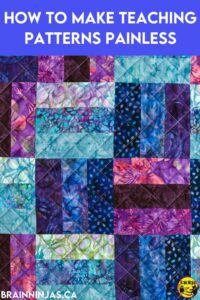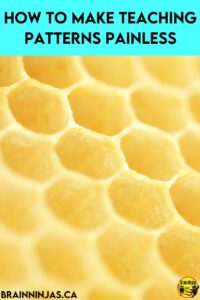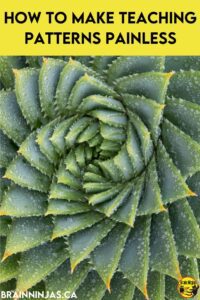
For younger grades, teaching patterns seems easier because the use of pattern blocks and colour makes it more fun and interesting. But older grades benefit from finding patterns, too. How do patterns help build math brains? They help teach number sense, develop numerical thinking, and help students make predictions based on what they know. Come learn some of the activities we use to make teaching patterns painless.
Teaching Patterns in Our World
There are many patterns that can be found in nature. Some students can spot these right away. Teaching students to spot patterns everywhere will make it easier when they need to describe pattern rules later.
Fibonacci Patterns
The spiral pattern of a nautilus shell is a beautiful example of the Fibonacci sequence. The shell’s intricate, swirling pattern is not only aesthetically pleasing but also provides the nautilus with structural strength and protection.
Snowflakes are another example of the Fibonacci sequence, with their six-pointed, symmetrical patterns. Each snowflake is unique, but they all follow the same basic pattern of branching and symmetry.
Geometric Patterns

The stripes on a zebra may seem random, but they actually follow a pattern of alternating black and white stripes that provides camouflage and protection from predators. The pattern also helps to regulate the zebra’s body temperature and may even help to deter biting insects.
The hexagonal pattern of honeycomb cells is not only beautiful but also serves an important purpose for honeybees. The shape of the cells allows for maximum storage and efficient use of space while supporting the hive.
Yupik patterns refer to the decorative motifs and designs used by the Yupik people, who are indigenous to Alaska and the eastern regions of Siberia. These patterns are typically found in Yupik art, such as basketry, weaving, and beadwork, and are often characterized by bold, geometric designs and bright, contrasting colours.
Tessellations are a type of pattern made up of repeated geometric shapes that fit together perfectly without any gaps or overlaps. The shapes can be simple, such as squares or triangles, or more complex, such as hexagons or octagons.
Number Patterns
When numbers follow a sequence based on a rule, it is called a number pattern. For example, counting by twos is a number pattern.
Arithmetic Patterns
Arithmetic patterns are also known as algebraic equations or expressions.
Teaching Patterns in the Classroom

We always start our patterns unit with a simple piece of graph paper. We ask students to use graph paper to make a pattern. Some students simply make a checkboard board. Other students make rows. And every once in and while students create amazing pieces of art.
The point is they all innately know about patterns. However, many students struggle with the vocabulary to describe the attributes of their patterns.
Teach students vocabulary to describe patterns. They should learn the different types of patterns, such as concrete or numerical. Concrete patterns are pictures or objects. Numerical patterns use numbers. Some patterns increase, decrease, or repeat. They can be finite or infinite.
Teaching students their ordinal numbers can help students describe the terms in a pattern.
Students can learn to describe attributes. This can be simple things like size or colour. Numbers can be described as odd, a multiple of 5, or by the number of digits it has.
Teaching Patterns With Interactive Notebooks

Some of these things need to be explicitly taught. That is why we use interactive notebooks. Students build a reference page for each of the aspects of learning about patterns. They can refer to this page as they work through the rest of the unit. To learn more about interactive notebooks, read our post How to Change Math With Interactive Notebooks.
Patterns and Algebra Interactive Notebook Grade 3 This focuses on concrete patterns and number sequences. Find it on TpT ($USD) or our BN Shop ($CAN).
Patterns and Algebra Interactive Notebook Grade 4 This focuses on pictorial, concrete, and number patterns. Algebraic expressions are introduced. Find it on TpT ($USD) or our BN Shop ($CAN).
Patterns and Algebra Interactive Notebook Grade 4/5 This focuses on concrete and number patterns. Algebraic expressions are introduced. Find it on TpT ($USD) or our BN Shop ($CAN).
Patterns and Algebra Interactive Notebook Grade 5 This focuses on concrete and number patterns. Find it on TpT ($USD) or our BN Shop ($CAN).
Patterns and Relations Interactive Notebook Grade 5/6 This focuses on concrete, number, pictorial, and arithmetic patterns, as well as writing algebraic expressions. Find it on TpT ($USD) or our BN Shop ($CAN).
Patterns and Algebra Interactive Notebook Grade 6 This focuses on concrete, pictorial, and number patterns, as well as writing algebraic expressions. Find it on TpT ($USD) or our BN Shop ($CAN).
Practicing Patterns With Task Cards
Task cards make it easy to break up questions so you can assess or practice specific concepts. You can learn more about how we use task cards in our classroom in our post, The Trouble With Task Cards and How to Fix It.
Patterns Task Cards Find it on TpT ($USD) or our BN Shop ($CAN)
Missing Addends Task Cards Find it on TpT ($USD) or our BN Shop ($CAN)
This set of Missing Digits (Addends/Subtrahends) Task Cards makes practicing easy. Find it on TpT ($USD) or our BN Shop ($CAN)
Missing Digits (Factors/Divisors) Task Cards Find it on TpT ($USD) or our BN Shop ($CAN)
Using Worksheets to Practice and Assess Patterns

While worksheets aren’t the best way to learn new material, they can be helpful in refining specific concepts. Sometimes, students need a little extra practice, or they make a great quick assessment. We put together a list of activities we use with worksheets in this post: Math Worksheet Games Your Students Will Love.
Algebra Worksheets
- Missing Digits: Addends and Subtrahends Worksheets. Find it on TpT ($USD) or our BN Shop ($CAN).
- Missing Digits: Factors and Divisions within 25 Worksheets. Find it on TpT ($USD) or our BN Shop ($CAN).
- Missing Digits: Factors and Divisions within 100 Worksheets. Find it on TpT ($USD) or our BN Shop ($CAN).
- Equality and Inequality Worksheets. Find it on TpT ($USD) or our BN Shop ($CAN).
- Writing Expressions and Equations With Variables Worksheets. Find it on TpT ($USD) or our BN Shop ($CAN).
- Solving Algebra Expressions and Equations | Addition and Subtraction Worksheets. Find it on TpT ($USD) or our BN Shop ($CAN).
- Solving Multiplication and Division Equations With Variables Worksheets. Find it on TpT ($USD) or our BN Shop ($CAN).
- Solving Algebra Expressions and Equations Using Order of Operations Worksheets. Find it on TpT ($USD) or our BN Shop ($CAN).
- Solving Expressions With Order of Operations and Brackets Worksheets. Find it on TpT ($USD) or our BN Shop ($CAN).
- Solving Equations With Order of Operations and Exponents Worksheets. Find it on TpT ($USD) or our BN Shop ($CAN).
- Solving Equations With Variables All Operations Worksheets. Find it on TpT ($USD) or our BN Shop ($CAN).
Patterns Worksheets
- Pattern Concepts Worksheets. Find it on TpT ($USD) or our BN Shop ($CAN).
- Simple Patterns Worksheets. Find it on TpT ($USD) or our BN Shop ($CAN).
- Describing and Extending Patterns Worksheets. Find it on TpT ($USD) or our BN Shop ($CAN).
- Patterns in Tables Worksheets. Find it on TpT ($USD) or our BN Shop ($CAN).
- Number Patterns | Sequences Worksheets. Find it on TpT ($USD) or our BN Shop ($CAN).
- Finding Patterns on Coordinate Planes Worksheets – Grade 5. Find it on TpT ($USD) or our BN Shop ($CAN).
- Pattern Concepts on a Coordinate Plane Worksheets – Grades 5-6. Find it on TpT ($USD) or our BN Shop ($CAN).
- Sorting Numbers In Charts By Attributes Worksheets. Find it on TpT ($USD) or our BN Shop ($CAN).
Extending Patterns Outside of Math Class
Create a Piece of Art With Tessellations
The key feature of a tessellation is that the shapes used to create the pattern must fit together without any gaps or overlaps. This requires careful planning and precision in the placement of each shape. The repetition of the shapes creates a sense of order and symmetry in the overall design, making tessellations both aesthetically pleasing and mathematically interesting.
Tessellations have been studied and appreciated by mathematicians and artists for centuries and have been used in a wide variety of contexts, from Islamic art and architecture to contemporary graphic design. They are a fascinating and beautiful example of the intersection between art and math and continue to inspire creativity and innovation in many different fields.
This website has amazing artwork from a variety of artists. It is a great example of different types of tessellations.
Need a simpler art project?
We use this name-patterning activity near the beginning of the school year to get to know our new students. It makes an equally great project during your patterns unit. We’ll send the Name Patterns project directly to your inbox when you sign up for our email list. If you’re already on the list, you can find it in our Resource Library.
Games to Practice Building Patterns
Do your students need more practice with patterns? This website has lots of simple games that don’t require anything more than an internet connection. Most of the patterns are concrete.
Board Games that Use Patterns
There are lots of board games that you can buy in retail stores that use patterns and are great for teaching patterns. Some of our favourites are Chess, Checkers, Chinese Checkers, Blokus, Qwirkle, and Azul. The game ‘Go’ is an ancient board game that involves placing stones on a grid to control territory. Players must create patterns of connected stones to form shapes and surround their opponent’s pieces.
Card Games that Use Patterns
There are lots of versions of solitaire that use playing cards. Most of these games use a red-on-black and black-on-red pattern while following a number sequence. Other card games that use patterns include SkipBo, Rummy, Phase 10, 7-Up, Hanabi, and Nertz.
Nertz is a Family Favourite
Nertz is a fast-paced, solitaire-style card game where multiple players race to create sequences of cards in numerical order. The goal of the game is to be the first player to empty their Nertz pile by playing all the cards.
Materials: a standard deck of 52 playing cards per player, a large playing area.
To begin the game, each player shuffles their deck and then deals themselves four piles of cards: the Nertz pile (face down, with the top card turned face up), the work pile (face down), the four-row tableau (with the first row consisting of one card, the second row consisting of two cards, and so on), and the foundation piles (which start empty).
Players try to play cards from their Nertz pile onto the shared playing area as quickly as possible. Any player can play in the shared area, but only the cards at the top of the tableau piles can be played in the foundation piles.
Players can also move cards between tableau piles, but they can only move one card at a time, and the cards must be in descending order and alternating colours (i.e. red-black-red-black). Players can also play cards from their work pile onto the tableau piles, but only if the cards are in descending order and alternating colours.
When a player empties their Nertz pile, they can start playing cards from their work pile onto the tableau piles. The first player to empty their Nertz pile and all four rows of their tableau wins the game.
You can also play in partners where one person holds the Nertz pile while the other player handles the rest of the cards.
Do You Teach Math?
You might find some of these posts helpful.
- How to Use Interactive Notebooks to Teach Number Sense
- Mastering the Angles: Innovative Approaches to Teaching Geometry Concepts
- How to Teach Students to Analyze Errors in Math
- How to Help Your Students Master Decimal Operations
- Ways to Bring Graphing Activities into Your Classroom Daily
- How to Add Candy to Your Math Lessons
- How to Teach Successful Long Division Strategies
- Conquer Math With These Proven Multiplication Strategies
- How to Differentiate Your Math Lessons
- Amazing Measurement Activities to Stretch Math
- Ways to Teach Classifying Triangles
- How to Teach Rounding Numbers
What are some of the pattern activities you love to use in your classroom? Let us know in the comments below.







